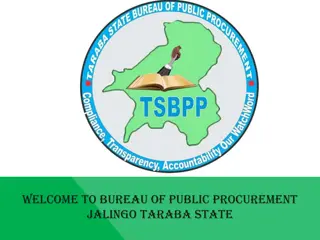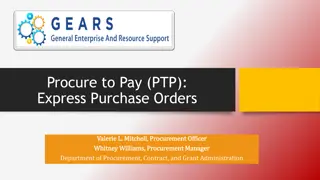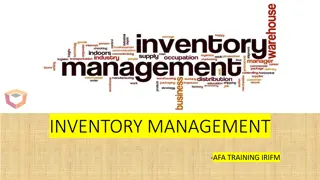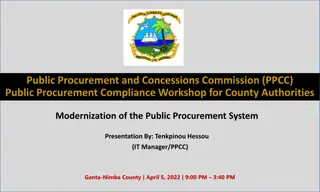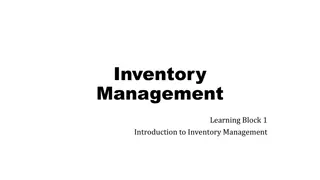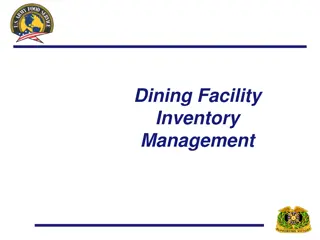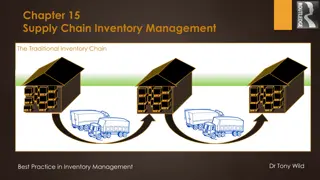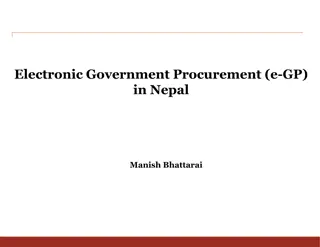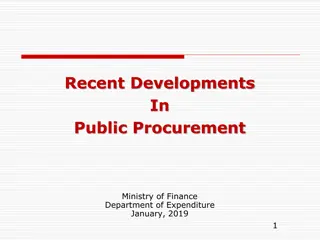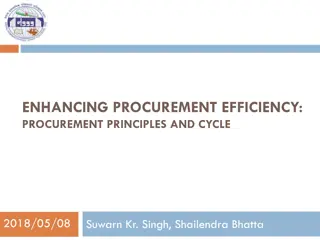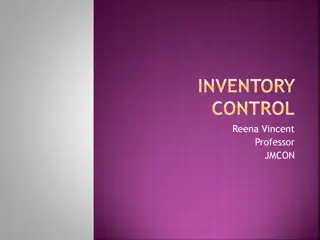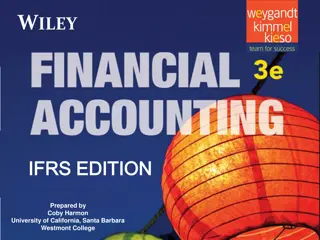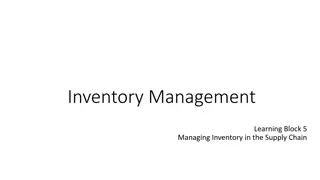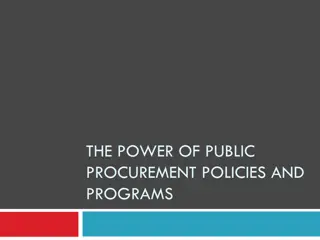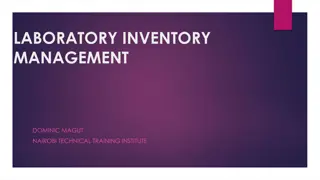Best Practices in Inventory Management and Procurement Strategies
Explore Dr. Tony Wild's insights on inventory management and procurement strategies, including Kraljic's Matrix for supplier relationships and attitudes towards manufacturing and customer needs. Learn about effective approaches to leverage, strategic, standard, and risk items to optimize inventory control and enhance supply chain efficiency.
Download Presentation

Please find below an Image/Link to download the presentation.
The content on the website is provided AS IS for your information and personal use only. It may not be sold, licensed, or shared on other websites without obtaining consent from the author. Download presentation by click this link. If you encounter any issues during the download, it is possible that the publisher has removed the file from their server.
E N D
Presentation Transcript
Best Practice in Inventory Management Chapter 9 Procurement Dr Tony Wild
Figure 9.1 Kraljic's Matrix Dr Tony Wild Leverage Items DescriptionCustomer controls supply Relationship Small Supplier reacts to large customer s whims Solution Benevolence, planned demand SituationSupplier has to be agile and therefore inefficient Strategic Items Description Products important to both parties Relationship Collaboration, Mutual Dependency Solution Single source, Communication Kanbans Situation High Volume A class items, Low stock Standard Items Description Standard products ex-stock, many potential suppliers Relationship Not close unless price advantage Solution Rationalise vendors, contracts, VMI SituationC class items, use alternative suppliers Risk Items Description Vendor dictates supply to Customer Relationship Large supplier, small customer. Usually poor delivery performance Solution Seek alternative supply Situation Patented product or bulk manufacturer Unimportant Important Importance to Customer
Figure 9.2 Supplier Attitudes Manufacturing Attitude Customer Attitude Compromise Provides products Supplier wants narrow range of options Bulk Low cost production Own design, efficient to produce Fill Capacity Delivery when available with lead time Long term fixed plan Generic service Make margin Avoid waste Efficient Manufacture Minimise cost to fulfil demand Requires solutions Customer sources wider range from each supplier Increased range secures customer Require time-phase deliveries Fits in with products from other suppliers Consistent Lead time Fast reliable service, ex-stock where possible Flexibility, respond to reasonable demand changesSchedule with flexibility options Different service for each customer Reduce cost Reliable products Small batches Convenient ordering process Supplier increases profit thought solutions Lean Production Master Schedule Demand sensitive design Manufacturer adopts lean supply Agreed delivery cycle plan Develop agile processes Improve efficiency & design Quality Stystems operating Reduce production change-over times Integrated systems, VMI Provide products philosophy Packaged items ready for customers to use or sell Customise products Dr Tony Wild Best Practice in Inventory Management
Figure 9.3 Single Sourcing Advantages & Disadvantages Supplier Customer Higher share of business Reduction in buying and paperwork Better opportunity to plan resources Less vendor management Advantages Confidence in continuing demand Opportunity for product and process development Regular demand More consistent quantities Improved Planning Better opportunity to plan resources "Base load" business Opportunity for added value services Repetitive consistent demand Supply can be lean Understand customer demand better More dependence on one customer Need to divulge financial information Sales volume depends on the Customer's success Customer may change supplier Customer may run into difficulties Expertise may be leaked to competitors Easier traceability for non-conformances Single shipping route Consolidated deliveries Faster replenishment cycle One Supplier responsible for each item Joint quality improvement processes Lower stock through co-ordinated supply Higher volume so more buying leverage Supply focussed on quality & efficiency Joint cost reduction programmes. More stable schedules Closer communication Supplier has too much power Risk of poor delivery performance Lack of flexibility Risks Supplier may cease trading Divulging sensitive information Dr Tony Wild Risk of quality problems Supplier may increase price once established as source Customer will squeeze price
Figure 9.3 Single Sourcing Advantages & Disadvantages Supplier Customer Higher share of business Better opportunity to plan resources Confidence in continuing demand Easier traceability for non- Reduction in buying and paperwork Advantages Less vendor management conformances Opportunity for product and process development Regular demand More consistent quantities Single shipping route Consolidated deliveries Faster replenishment cycle One Supplier responsible for each item Improved Planning Better opportunity to plan resources Joint quality improvement processes Lower stock through co-ordinated supply Higher volume so more buying leverage Supply focussed on quality & efficiency Joint cost reduction programmes. "Base load" business Opportunity for added value services Repetitive consistent demand Supply can be lean Understand customer demand better More dependence on one customer Need to divulge financial information Sales volume depends on the Customer's success Customer may change supplier Customer may run into difficulties More stable schedules Closer communication Supplier has too much power Risk of poor delivery performance Lack of flexibility Risks Supplier may cease trading Divulging sensitive information Expertise may be leaked to competitors Dr Tony Wild Risk of quality problems Supplier may increase price once established as source Customer will squeeze price Best Practice in Inventory Management
Size Figure 9.4 Partner Selection Checklist Market compatibility Corporate Objectives and Strategy Management Style & Ethics Marketing approach Profitability Geographic location Compatibility Product Consistency Supply Reliability Operational Capability Information Structure Interpersonal Match Development Opportunities History Dr Tony Wild
Figure 9.5 Classification of suppliers Status Inspection Vendor Class First choice. Close relationship Capability Audit Certified Trusted Suppliers. Industry Accreditation No inspection Select group of suppliers Audit and Sample Qualified Business Quality Audited Inspection Offered expanding business Used occasionally or Standard items Conformance Certification or full Items not available elsewhere Approved Prototypes, non -inventory items, inspection office supplies Avoid using exce pt where unavoidable 100% detailed Proscribed Dr Tony Wild inspection Best Practice in Inventory Management








